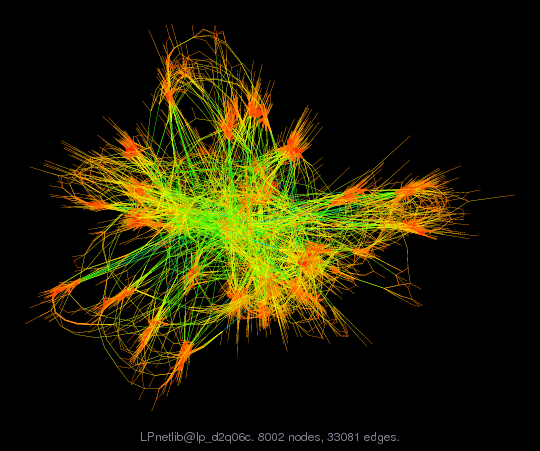
Matrix: LPnetlib/lp_d2q06c
Description: Netlib LP problem d2q06c: minimize c'*x, where Ax=b, lo<=x<=hi
 |
| (bipartite graph drawing) |
 |
 |
| Matrix properties | |
| number of rows | 2,171 |
| number of columns | 5,831 |
| nonzeros | 33,081 |
| structural full rank? | yes |
| structural rank | 2,171 |
| # of blocks from dmperm | 11 |
| # strongly connected comp. | 1 |
| explicit zero entries | 0 |
| nonzero pattern symmetry | 0% |
| numeric value symmetry | 0% |
| type | real |
| structure | rectangular |
| Cholesky candidate? | no |
| positive definite? | no |
| author | J. Tomlin |
| editor | D. Gay |
| date | 1989 |
| kind | linear programming problem |
| 2D/3D problem? | no |
| Additional fields | size and type |
| b | full 2171-by-1 |
| c | full 5831-by-1 |
| lo | full 5831-by-1 |
| hi | full 5831-by-1 |
| z0 | full 1-by-1 |
Notes:
A Netlib LP problem, in lp/data. For more information
send email to netlib@ornl.gov with the message:
send index from lp
send readme from lp/data
The following are relevant excerpts from lp/data/readme (by David M. Gay):
The column and nonzero counts in the PROBLEM SUMMARY TABLE below exclude
slack and surplus columns and the right-hand side vector, but include
the cost row. We have omitted other free rows and all but the first
right-hand side vector, as noted below. The byte count is for the
MPS compressed file; it includes a newline character at the end of each
line. These files start with a blank initial line intended to prevent
mail programs from discarding any of the data. The BR column indicates
whether a problem has bounds or ranges: B stands for "has bounds", R
for "has ranges".
The optimal value is from MINOS version 5.3 (of Sept. 1988)
running on a VAX with default options.
PROBLEM SUMMARY TABLE
Name Rows Cols Nonzeros Bytes BR Optimal Value
D2Q06C 2172 5167 35674 258038 1.2278423615E+05
Bob Bixby reports that the CPLEX solver (running on a Sparc station)
finds slightly different optimal values for some of the problems.
On a MIPS processor, MINOS version 5.3 (with crash and scaling of
December 1989) also finds different optimal values for some of the
problems. The following table shows the values that differ from those
shown above. (Whether CPLEX finds different values on the recently
added problems remains to be seen.)
Problem CPLEX(Sparc) MINOS(MIPS)
D2Q06C 1.2278423521E+05
From John Tomlin.
On the problems supplied by John Tomlin, MINOS 5.3 reports that about
10% to 57% of its steps are degenerate:
Name Steps Degen Percent
D2Q06C 42417 4223 9.96
Added to Netlib on 30 Oct. 1989
| Ordering statistics: | result |
| nnz(V) for QR, upper bound nnz(L) for LU, with COLAMD | 1,503,123 |
| nnz(R) for QR, upper bound nnz(U) for LU, with COLAMD | 175,041 |
| SVD-based statistics: | |
| norm(A) | 3568.33 |
| min(svd(A)) | 0.0247562 |
| cond(A) | 144139 |
| rank(A) | 2,171 |
| sprank(A)-rank(A) | 0 |
| null space dimension | 0 |
| full numerical rank? | yes |
| singular values (MAT file): | click here |
| SVD method used: | s = svd (full (A)) ; |
| status: | ok |

For a description of the statistics displayed above, click here.
Maintained by Tim Davis, last updated 12-Mar-2014.
Matrix pictures by cspy, a MATLAB function in the CSparse package.
Matrix graphs by Yifan Hu, AT&T Labs Visualization Group.